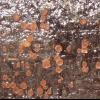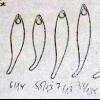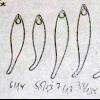
15-12-2025 15:48
 Danny Newman
Danny Newman
Melanospora cf. lagenaria on old, rotting, fallen

15-12-2025 15:54
 Johan Boonefaes
Johan Boonefaes
Unknown anamorph found on the ground in coastal sa

15-12-2025 21:11
 Hardware Tony
Hardware Tony
Small clavate hairs, negative croziers and IKI bb

15-12-2025 07:09
 Danny Newman
Danny Newman
indet. Rutstroemiaceae sp. on unk. fallen leavesMc

15-12-2025 07:05
 Danny Newman
Danny Newman
Pseudosclerococcum golindoi (det: Zotto)near Cosb

15-12-2025 11:49
 Danny Newman
Danny Newman
ITS sequences from the following two collections B

15-12-2025 12:34
 Danny Newman
Danny Newman
indet. Rhytismataceae on oak leafnear Purchase Roa

09-12-2025 12:06
 Andgelo Mombert
Andgelo Mombert
Bonjour,Je recherche l'article concernant Hypobryo
Hyalina ?
Yannick Mourgues,
08-03-2007 23:19
 Bonsoir.
Bonsoir.J'ai trouvé cet aprèm cet asco que vous pouvez voir ci-dessous. En grand nombre sur écorces de hêtre.
Macro :
Fructification de diamètre = 0,5mm environ, orbiculaire à cupuliforme étalé, hyménium et excipulum de couleur rose, sessile, marge irrégulière.
Micro :
Asques 35-40 par 3-4 um, I-, Spores bissériés
Spores lisses fusiformes 6-8 par 1 um
Paraphyses hyalines, cylindriques, à sommet recouvert de toute petites granulations "en gelée" qui les agglomèrent les unes aux autres. Dimensions identiques aux asques. Cloisons.
Voir dessins micro ci-dessous.
Je pense que je suis là dans la famille des Orbiliaceae et je pensais à un genre comme Hyalinia ou Orbilia, sans arriver à un nom d'espèce.
Avez-vous une idée ?
Merci par avance.
Yannick Mourgues
Perz Piotr,
08-03-2007 23:24
Re:Hyalina ?
Sure, Orbilia :) Very pretty :)
We must wait for Zotto ;)
We must wait for Zotto ;)
Hans-Otto Baral,
17-03-2007 23:49

Re:Hyalina ?
Cher Yannick
I am sorry to comment so late, I had no access to Ascofrance for some weeks. Very interesting collection. Although we know several hundreds of Orbilia species I am unable to name this one. The enlarged image is still a but too small, but the margin looks a bit crenulate. It would be interesting to know of what kind of hairs are at the margin. I assume the asci have a thin stalk and furcate base. The spore shape is very important in Orbilia. Was it really such simple, or perhaps curved or more narrowed at the base? Did you examine it in water, and was there no guttule at the spore apex?
Finally, was it a branch or trunk lying on the moist ground, or was the bark exposed to drying out? The rose colour might tell for a xerotolerant species. What I have in mind is Orbilia rubella, but that has thick-walled septate hairs.
If you wish you may send the collection to my address:
Zotto
Hans-Otto Baral
Blaihofstr. 42
D-72074 Tuebingen
I am sorry to comment so late, I had no access to Ascofrance for some weeks. Very interesting collection. Although we know several hundreds of Orbilia species I am unable to name this one. The enlarged image is still a but too small, but the margin looks a bit crenulate. It would be interesting to know of what kind of hairs are at the margin. I assume the asci have a thin stalk and furcate base. The spore shape is very important in Orbilia. Was it really such simple, or perhaps curved or more narrowed at the base? Did you examine it in water, and was there no guttule at the spore apex?
Finally, was it a branch or trunk lying on the moist ground, or was the bark exposed to drying out? The rose colour might tell for a xerotolerant species. What I have in mind is Orbilia rubella, but that has thick-walled septate hairs.
If you wish you may send the collection to my address:
Zotto
Hans-Otto Baral
Blaihofstr. 42
D-72074 Tuebingen
Yannick Mourgues,
18-03-2007 18:17

Re:Hyalina ?
Bonjour et merci pour votre réponse.
La micro s'est faite avec Rouge congo puis bleu coton. Pas fait dans l'eau.
Ces exemplaires étaient sur les écorces de bûches de hêtres, sur la face exposée à l'air libre. Rien en-dessous.
Je vous envoie donc un échantillon à votre adresse. C'est bien en Allemagne ?
On écrit Tuebingen ou tübingen ?
Merci d'avance.
Cordialement
Yannick Mourgues
La micro s'est faite avec Rouge congo puis bleu coton. Pas fait dans l'eau.
Ces exemplaires étaient sur les écorces de bûches de hêtres, sur la face exposée à l'air libre. Rien en-dessous.
Je vous envoie donc un échantillon à votre adresse. C'est bien en Allemagne ?
On écrit Tuebingen ou tübingen ?
Merci d'avance.
Cordialement
Yannick Mourgues
Hans-Otto Baral,
18-03-2007 23:23

Re:Hyalina ?
Hi Yannick
Glad to receive the specimen. Tübingen is correct. Mounting in bleu coton is not good for ascos, because very valuable cell inclusions get lost. Orbilia is often not determinable without the spore body inside the spores.
In vivo veritas!
Zotto
Glad to receive the specimen. Tübingen is correct. Mounting in bleu coton is not good for ascos, because very valuable cell inclusions get lost. Orbilia is often not determinable without the spore body inside the spores.
In vivo veritas!
Zotto
Hans-Otto Baral,
23-03-2007 23:07

Re:Hyalina ?
Dear Yannick
today arrived your fine collection, many thanks! It is actually a xerotolerant Orbilia with distinct white hairs. Previously I would have identified it as O. rubella, but since I studied Persoon´s authentic specimen in Leiden I use that name for a similar species with larger spores and long glassy processes on the hairs. For your specimen no published name is available, and we created the name O.phragmotricha for it, referring to the septate thick-walled hairs. The spores have a short but distinct tail and a small tear-shaped apical spore body. Our studied collections were usually on bark of Salix, also Populus, rarely Tilia or Rhamnus. Your find can hardly be on Fagus, the bark looks very different. What could it be else? The images are all from your collection.
Please tell me more about the collection data (dept., site name, what trees in the forest).
Cheers
Zotto
today arrived your fine collection, many thanks! It is actually a xerotolerant Orbilia with distinct white hairs. Previously I would have identified it as O. rubella, but since I studied Persoon´s authentic specimen in Leiden I use that name for a similar species with larger spores and long glassy processes on the hairs. For your specimen no published name is available, and we created the name O.phragmotricha for it, referring to the septate thick-walled hairs. The spores have a short but distinct tail and a small tear-shaped apical spore body. Our studied collections were usually on bark of Salix, also Populus, rarely Tilia or Rhamnus. Your find can hardly be on Fagus, the bark looks very different. What could it be else? The images are all from your collection.
Please tell me more about the collection data (dept., site name, what trees in the forest).
Cheers
Zotto
Yannick Mourgues,
25-03-2007 17:15

Re:Hyalina ?
Dear Zotto.
Thanks a lot for having studiing my collection. As I told you before, the bark was exposed to drying out.
I have gone again to the Boscodon' forest this week for having a look to trees that are growing all around the place where I have found our Orbilia .
I have seen only five trees :
The most communs are : Fagus silvatica, Abies alba and Picea abies.
I have seen too : Corylus avellanus and Sorbus aucuparia
I think our collection was growing on Fagus. It can't be an Abies or a Picea.
Here what you wanted to know :
Found in France
dept.: Hautes-Alpes (05)
Site name : Forêt du Boscodon
Alt. : 1000m
Thank's a lot.
Cheers.
Yannick Mourgues
Thanks a lot for having studiing my collection. As I told you before, the bark was exposed to drying out.
I have gone again to the Boscodon' forest this week for having a look to trees that are growing all around the place where I have found our Orbilia .
I have seen only five trees :
The most communs are : Fagus silvatica, Abies alba and Picea abies.
I have seen too : Corylus avellanus and Sorbus aucuparia
I think our collection was growing on Fagus. It can't be an Abies or a Picea.
Here what you wanted to know :
Found in France
dept.: Hautes-Alpes (05)
Site name : Forêt du Boscodon
Alt. : 1000m
Thank's a lot.
Cheers.
Yannick Mourgues
Yannick Mourgues,
25-03-2007 17:17

Re:Hyalina ?
Dear Zotto.
Can I use your images for my futur web-site ?
Yannick Mourgues
Can I use your images for my futur web-site ?
Yannick Mourgues
Hans-Otto Baral,
25-03-2007 22:21

Re:Hyalina ?
Dear Yannick
no problem!
I will investigate the bark . I know Fagus bark very well, but yours isn´t.
Zotto
no problem!
I will investigate the bark . I know Fagus bark very well, but yours isn´t.
Zotto
Yannick Mourgues,
07-04-2007 16:54

Re:Hyalina ?
Dear Zotto.
I have seen another tree around the place where i found this species. I join an image where we can see leaves. May be it's the tree we are looking for ?
Do you know it's name ? I don't.
Yannick Mourgues
I have seen another tree around the place where i found this species. I join an image where we can see leaves. May be it's the tree we are looking for ?
Do you know it's name ? I don't.
Yannick Mourgues
Guy Garcia,
07-04-2007 17:45
Re:Hyalina ?
feuilles d'Alnus ?
Hans-Otto Baral,
07-04-2007 19:55

Re:Hyalina ?
I would say Fagus. What about this bark, was it still attached to the branch? It is very easy to recognize Fagus from a cross section of wood under the bino.
Zotto
Zotto
Michel Hairaud,
07-04-2007 23:08

Re:Hyalina ?
Je ne crois pas qu'il s'agisse de feuilles de Fagus car la marge semble dentée.
Peut être Salix ou alnus, voire même Rhamnus ?
Michel
Peut être Salix ou alnus, voire même Rhamnus ?
Michel





 1769.jpg
1769.jpg


